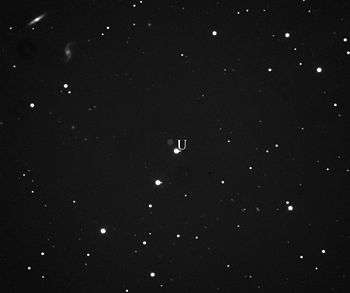375 Ursula
| Discovery | |
|---|---|
| Discovered by | Auguste Charlois |
| Discovery date | September 18, 1893 |
| Designations | |
| Pronunciation | /ˈɜːrsjʊlə/ or /ˈɜːrsələ/[1] |
| 1893 AL | |
| Main belt | |
| Orbital characteristics | |
| Epoch 30 January 2005 (JD 2453400.5) | |
| Aphelion | 3.46 AU (517.593 Gm) |
| Perihelion | 2.789 AU (417.247 Gm) |
| 3.125 AU (467.42 Gm) | |
| Eccentricity | 0.107 |
| 5.52 a (2017.268 d) | |
Average orbital speed | 16.85 km/s |
| 85.323° | |
| Inclination | 15.931° |
| 336.686° | |
| 344.757° | |
| Physical characteristics | |
| Dimensions |
191.65 ± 4.01 km[2] 216±10 km[3][4][5] |
| Mass | (8.45 ± 5.26) × 1018 kg[2] |
Mean density | 2.29 ± 1.43[2] g/cm3 |
| 16.83 hr[4] | |
| 7.47[4] | |
|
| |
375 Ursula is one of the largest asteroids from the asteroid belt. It was discovered by Auguste Charlois on September 18, 1893, in Nice, France.
Observations of an occultation on November 15, 1984, produced six chords indicating an estimated diameter of 216±10 km.[3]

Asteroid 375 Ursula (apparent magnitude 11.4) near the star TYC 581-36-1 (magnitude 11.9). The two galaxies are about magnitude 15.
References
- ↑ UR-sew-lə or UR-sə-lə
- 1 2 3 Carry, B. (December 2012), "Density of asteroids", Planetary and Space Science, 73, pp. 98–118, arXiv:1203.4336
 , Bibcode:2012P&SS...73...98C, doi:10.1016/j.pss.2012.03.009. See Table 1.
, Bibcode:2012P&SS...73...98C, doi:10.1016/j.pss.2012.03.009. See Table 1. - 1 2 Millis, R.L; Wasserman, Bowell; Franz, Klemola; Dunham (1984). "The diameter of 375 URSULA from its occultation of AG + 39 deg 303". Astronomical Journal. 89: 592–596. Bibcode:1984AJ.....89..592M. doi:10.1086/113553.
- 1 2 3 "JPL Small-Body Database Browser: 375 Ursula (1893 AL)". Retrieved 2008-05-22.
- ↑ "Occultation of UCAC2 12060928 by 375 Ursula". Royal Astronomical Society of New Zealand. 2008-05-27. Retrieved 2008-11-30.
External links
- Orbital simulation from JPL (Java) / Ephemeris
- 375 Ursula at the JPL Small-Body Database

This article is issued from Wikipedia - version of the 9/10/2016. The text is available under the Creative Commons Attribution/Share Alike but additional terms may apply for the media files.
